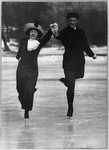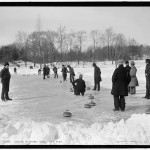This is the perfect time to write about winter sports with the excitement of the 2010 Vancouver Winter Olympic Games fresh in our minds. A few years ago I did an exhibit of the Library’s winter sport and game books from 1800- 1950. The following are selected examples of notable works I used for the display:

Sunday morning relaxation. Park Pond. Frequented by both school and mill boys and girls. Location: New Bedford, Massachusetts (1912)
Ice Hockey
“He Shoots, He Scores!” exclaimed premier hockey broadcaster Foster Hewitt who was the first to coin the phrase. Hockey enthusiasts have Mr. Hewitt to thank for bringing play-by-play broadcasts of the game to homes in Canada and the U.S., beginning in the 1920’s. If you are interested in the history of the sport, check out Mr. Hewitt’s 1938 Down the ice . You also might want to check out Canadian Broadcasting Centre’s Digital Archives- The Voice of Hockey: Foster Hewitt
Figure stating
In the early 20th century, George H. Browne, president of the Cambridge (MA) Skating Club, and Irving Brokaw, a national figure-skating champion, both made contributions to the techniques of ice skating. It was Browne, author of the first how- to figure skating books in North America, who first brought the international style to the United States, although Browne and Brokaw worked together. Many consider Browne the instructor and Brokaw the demonstrator.
Partnering with the Sloan Foundation and the Internet Archive, the Library is in the process of digitizing a collection of our pre-1923 books. Now you can read a copy of Irving Brokaw’s 1913 Art of skating right in the comfort of your home.
George H. Browne’s 1900 Handbook of figure skating arranged for the use on ice can be read via Google Books.
Curling
I have noticed much debate on what curling is and whether it’s a sport or game. Whatever your opinion of curling, its origins date back to 16th century Scotland. John Kerr’s 1890 History of curling and fifty years of the Royal Caledonian Curling Club provides an in-depth history of curling (you can read a digital copy via Google Books -History of curling )
Skiing
Sir Arnold Henry Moore Lunn, credited with inventing the modern slalom ski race in 1922, was a leading authority on skiing and authored many books about skiing. His 1920 Cross-country ski-ing provided a practical how- to for the beginner and his follow-up 1921 Alpine ski-ing at all heights and seasons, which includes a discussion on avalanches, is recognized as a classic. (As far as I can tell, these titles are not yet available in digital form)
The Library has also digitized many of the early Spalding Athletic series. Here are some titles related to winter sports:
Spalding’s 1916 How to play hockey
Spalding’s 1913 How to become a skater
Spalding’s 1921 Figure skating for women
Spalding’s 1899 Curling: complete rules and regulations, with diagrams of play
You might want to take a look at: Olympic games handbook; containing official records of the seventh Olympiad, winners in previous Olympiads, the 1924 Olympic games, official Olympic athletic rules and the official world’s records and noteworthy performances ( The 1924 Summer Olympics hosted an International Winter Sports Week which included hockey, skating, and skiing.)
You can find more of our digitized books from the Internet Archive Library of Congress page.



